By Ramit Singal
There are four species of leafbirds (also known as chloropsis) found in India and they never fail to enthral a birder. Each of them is largely green, slender in build, with a medium-length tail and the habit of dwelling in the top or mid-canopy. They feed on fruits, insects and even nectar.
The Orange-bellied Leafbird Chloropsis hardwickii is restricted to the lower and middle Himalayas, the Blue-winged Leafbird Chloropsis cochinchinensis is found in the North-eastern lowlands (and further up in the Cachar Hills as well), while the very similar (and recently split from Blue-winged) Jerdon’s Leafbird Chloropsis jerdoni is found throughout much of the peninsula. The Golden-fronted Leafbird Chloropsis aurifrons is widespread across the entire region, overlapping in range with all the other subcontinental leafbirds.
A pair of Golden-fronted Leafbirds:
All the species are usually seen in pairs or in loose flocks. In the non-breeding seasons, they are often seen in mixed flocks and hunting parties.
This article looks at the two frequently confused leafbirds – Golden-fronted and Jerdon’s – that are recorded most often, and explains they key features to identify one from the other.
Golden-fronted and Jerdon’s Leafbirds
Basic Differences
| Golden-fronted Leafbird | Jerdon’s Leafbird | |
|---|---|---|
| Bill | Long, slim and decurved | Heavier, shorter, less curved |
| Face Mask: | ||
| Male | Extensive, covers entire cheek and runs down to the breast | Large but only up to cheek and entire throat |
| Female | Similar to male | Blue, brighter on moustache |
| Juvenile | No mask, blue moustache | Blue moustache, Yellow eye-ring |
| Forehead | Orange, but restricted in females and missing in juveniles | Dull yellow |
| Upper parts | Green nape, head and mantle but juvenile is dull | Dull yellow wash on head, breast, nape and upto mantle |
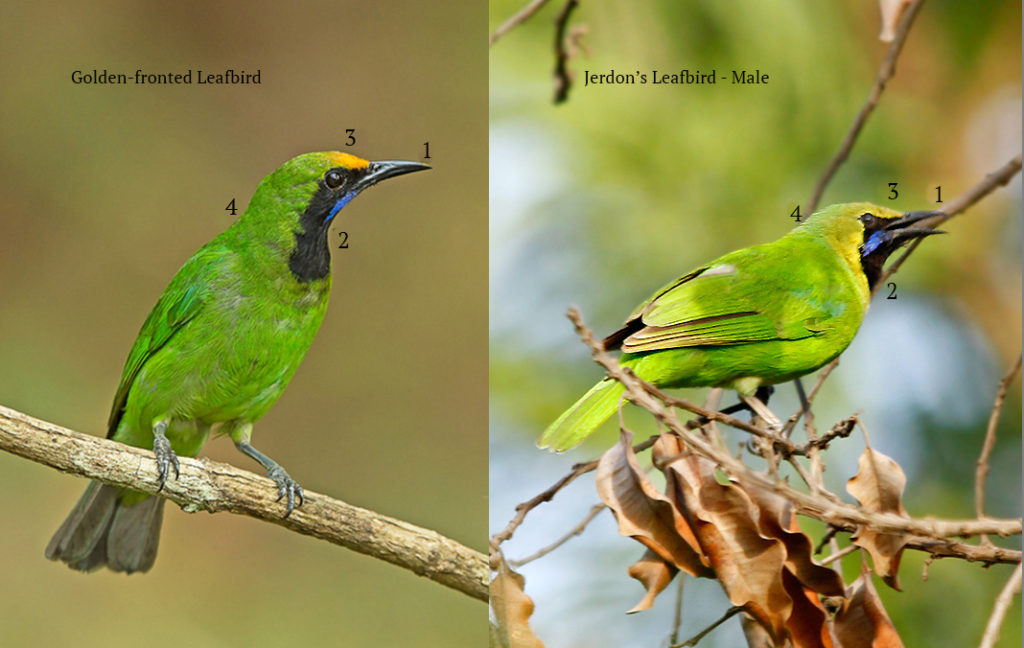
1. Beak – Longer and slimmer in Golden-fronted, Heavy and short in Jerdon’s
2. Extensive face mask in Golden-fronted, not as extensive on Jerdon’s (esp cheeks)
3. Golden-forehead on Golden-fronted vs dull yellow on Jerdon’s
4. Green overall on Golden-fronted, dull yellow nape and head on Jerdon’s Leafbird
Golden-fronted Leafbird (Left) © Panchami Manoo Ukil (checklist)
Jerdon’s Leafbird (Right) © Bhavesh Mengar (checklist)
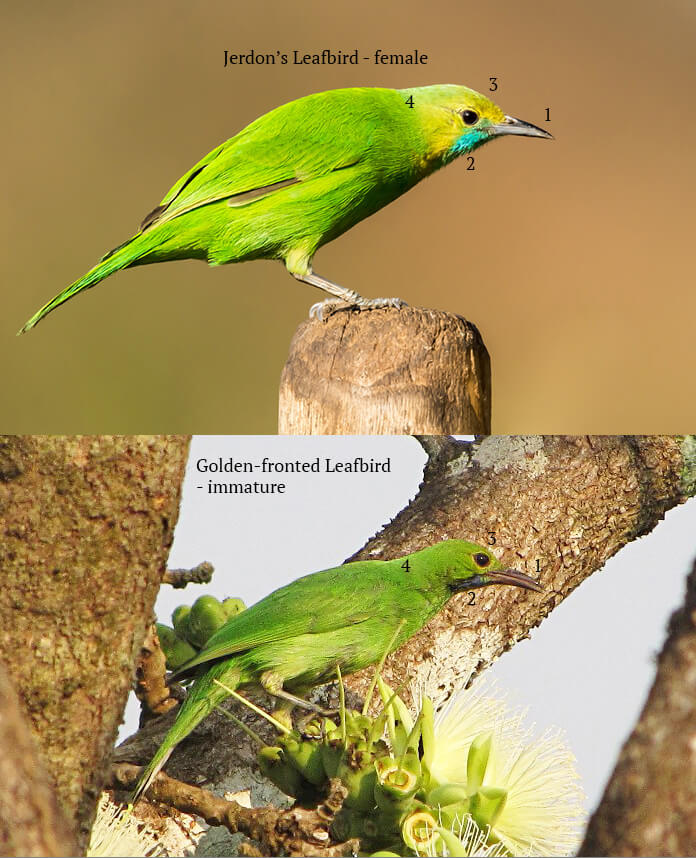
1. Beak – Shorter and thicker in Jerdon’s Leafbird, long and slim in Golden-fronted
2. Turquoise Blue moustache in Jerdon’s Leafbird, blue patch on imm Golden-fronted
3. Dull yellow forehead on Jerdon’s vs yellowish forehead on Golden-fronted
4. Dull yellow wash on head and nape in Jerdon’s Leafbird, female (Top) © Ramesh Desai (checklist)
Golden-fronted Leafbird, immature (Bottom) © Ramit Singal
Calls
All leafbirds may sound extremely similar to the untrained ear. Most calls are a mixture of harsh and sweet notes with some differences in quality. Leafbirds are also excellent mimics and often have an impressive repertoire of sounds that may cause confusion amongst several birders!
Have a listen to the song of the Golden-fronted Leafbird and the Jerdon’s Leafbird to understand how similar they can be!
Do check out other calls of the Golden-fronted Leafbird, Jerdon’s Leafbird, Blue-winged Leafbird and the Orange-bellied Leafbird.
Habitat
| Golden-fronted Leafbird | Jerdon’s Leafbird | |
|---|---|---|
| Landscape level | Prefers wetter regions with evergreen and deciduous forests | Prefers drier and more arid regions with deciduous scrub and forests |
| Site level | Dense forest patches as well as gardens, groves and woodlands | Gardens, scrub, woodlands with lower tree densities |
Some helpful notes
a. Habitat may often be a pointer to what leafbird you are seeing. If you are in a rainforest, you are most likely to see a Golden-fronted Leafbird, while a dry scrubland with scattered trees will most probably have only Jerdon’s Leafbirds. However, many regions – such as the western coast, central Indian forests and parts of the eastern ghats may have both species co-existing (in variable numbers).
b. Leafbird juveniles are tricky and often require a good look, with multiple features noted, before an ID can be finalised.
c. Seeing a pair often aids in identification as Golden-fronted Leafbirds do not exhibit the obvious sexual dimorphism that the Jerdon’s Leafbirds show.
d. In case of any doubts, eBird provides the option of using Jerdon’s/Golden-fronted Leafbird and Leafbird sp.
Blue-winged Leafbird
The Blue-winged Leafbird is similar to Jerdon’s Leafbird but allopatric (i.e. populations of the two are geographically isolated from each other). It has blue on the primaries (outermost group of flight feathers) and the tail, while the face mask is even smaller. The male has a bright yellow border to the face patch.
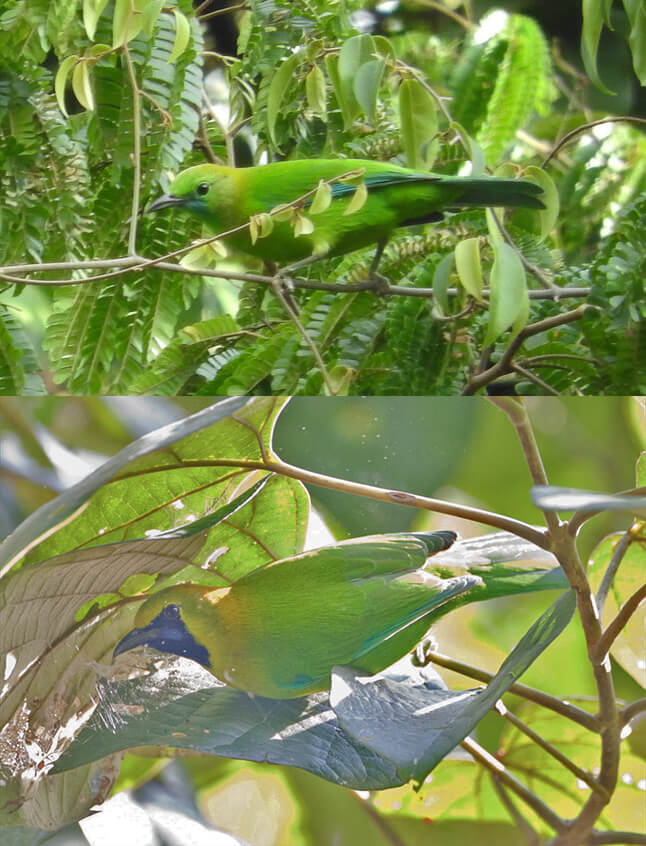
Note patches of blue on wings and tail. Female (above) has no face mask, while the male (below) has a smaller face mask than Jerdon’s with a very obvious bright yellow border. Beak is thick and short.
Blue-winged Leafbird female (above) © Pam Rasmussen (checklist)
Blue-winged Leafbird male (below) © Collin DeBuysere (checklist)
Orange-bellied Leafbird
The most distinctive of our leafbirds thanks to the obvious orange underparts. The face mask on the male is large and elaborate while the female only shows a blue moustache. The bill is longer than that of the Blue-winged Leafbird. The male also has dark blue wings and tail.
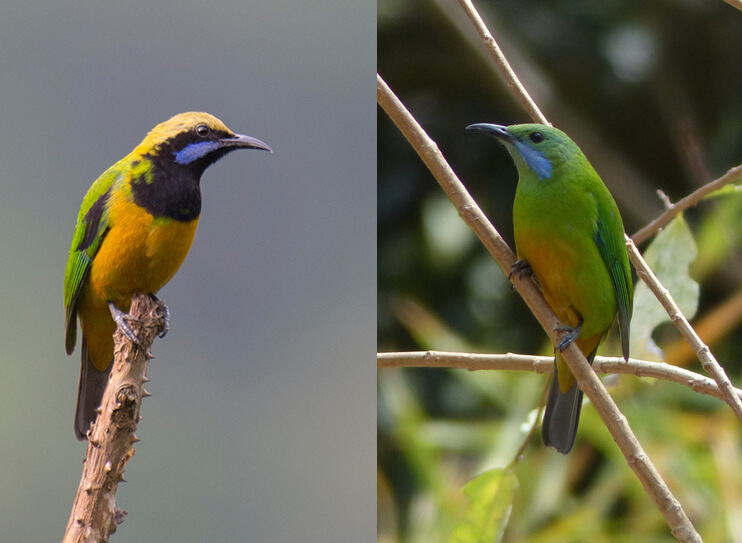
Note blue on wings, large face mask and orange belly on male (Left) and the blue moustache on the female (Right). The beak is large and long.
Orange-bellied Leafbird male (R) © Amatya Sharma (checklist)
Orange-bellied Leafbird female (L) © Ashwin Viswanathan (checklist)

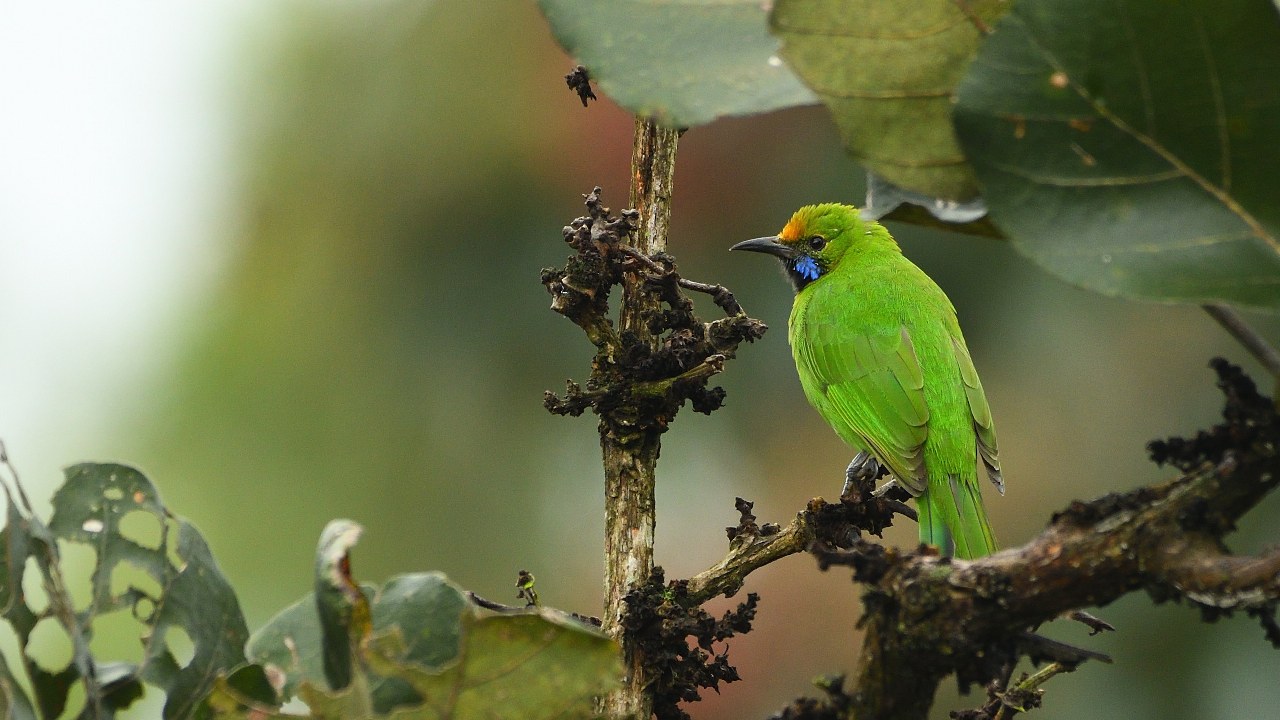
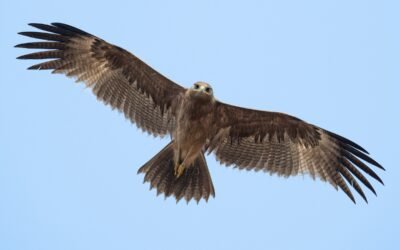
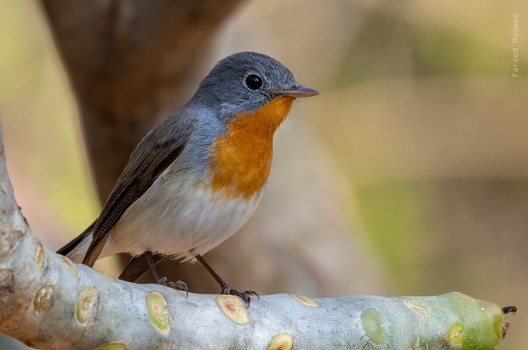
Sir,
Please let me know any such activities in Hyderabad
Sir, please contact “Birdwatchers’ Society of Andhra Pradesh” and “Hyderabad Birding Pals”. Googling the names will lead you to the contact details. Happy birding!
A very handy guide. The Jerdon’s and Golden-fronted are frequently confused but this guide really calls out the subtler differences. Habitat clues are well spelt out too. Thank you.
The leaf bird upload is fine. Congrats.
Nice and detailed information. Always get confused between the jerdon’s and golden fronted.
Good one
Very Useful and handy easy to differenciate between among sp. Very good job.Thanks.
Very informative and detailed study. Thank you very much.
Nice description!